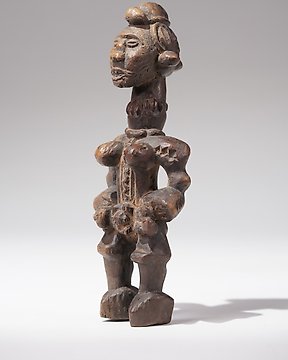
Senufo - Costa de Marfil (Sin Precio de Reserva)
N.º 84045047

N.º 84045047

A Senufo guardian sculpture, Northern Ivory Coast, rising from a cylindrical base, short thick legs, which emerge directly from the base, an abstract loincloth, a slender thin torso with a protruding navel, which is marked by horizontal scarifications, the breasts pointing forward, remarkable elongated arms, odouble-edged knife in the left hand and a fetish bell in the right hand. On the top of the head sits a plaque attachment with an X carved out in the middle. The plaque attachment means that the object plays a double role: First it is a field guard and second it plays a ceremonial role. Fine scarifications on the body and face. Encrusted dark brown patina. Certificate origin and provenance.
Burkhard Gottschalk writes that this is not a rhythm pounder (Débéle, do:ogèlè), but a very rare stationary used guardian figure. These sculptures are called propi:ibèlè, „children of the Poro".
"Their membership of the Poro would be an explanation for our little knowledge of their significance, because this organisation, which largely determines the village world of the Senufo, is a secret society. ... Even rarer are the statues [propi:ibèlè] … of which it is only said that they belong to the Poro, because there is no reliable information about their use.“ Burkhard Gottschalk, Kunst aus Schwarzafrika. SENUFO. Unbekannte Schätze aus privaten Sammlungen, 2009, p.174, 179.
Lit.: Burkhard Gottschalk, Senufo. Massa und die Statuen des Poro, 2002; Staatliche Museen der Preußischer Kulturbesitz, Museum für Völkerkunde Berlin, Die Kunst der Senufo, Elfenbeinküste. Mit einem Beitrag von Till Förster, 1990; Museum Rietberg Zürich, Die Kunst der Senufo aus Schweizer Sammlungen, 1988; Susan Elizabeth Gagliardi, Senufo unbound. Dynamics of art and identity in West Africa, Cleveland 2015 page 78, Fig. 41 Private collection McClain Gallery, Houston, Sothe bys, 14 November, 2008, Lot 63.
"Auf den Auktionen wird in jüngerer Zeit nur noch gelegentlich ein altes und bedeutendes Exemplar dieser Statuen (deble) angeboten. Wegen der Aura, von denen die Deble auf Grund ihrer Verwendung bei Beerdigungen umgeben zu sein scheinen, und wegen ihrer Seltenheit stehen diese Statuen bei den Sammlern in einem hohen Ansehen. Noch seltener werden die stationär benurtzen Statuen mit flachem Sockel angeboten, von denen es lediglich heißt, daß sie zum Poro gehören, denn über ihre Verwendung liegen keine gesicherten Erkenntnisse vor." Gottschalk, Kunst aus Schwarz Afrika, Vol. 3, page 179.
Lit.: Kat. Ausst. Die Kunst der Senufo, Elfenbeinküste. Mit einem Beitrag von Till Förster, Museum für Völkerkunde Berlin 1990. Burkhard Gottschalk, Senufo. Massa und die Statuen des Poro, Düsseldorf 2002. Susan Elizabeth Gagliardi, Senufo unbound. Dynamics of art and identity in West Africa, 2015. Till Förster, Smoothing the Way of the Dead, A Senufo Rhythm Pounder, Yale University Art Gallery Bulletin (2005).
Cómo comprar en Catawiki
1. Descubre algo especial
2. Haz la puja más alta
3. Paga de manera segura